|
|
|
||||||||||||||||||||||||||||||||||||||||||||||||||||||||||||||||||||||||||||||||||||||||||||||||||||||||||||||||||||||||||||||||
SOLAR WEATHER
and some interesting space stuff
2010
compiled by Dee Finney
MAY - 2010
PAGE 5
updated - 5-31-10
THIS COMPILATION IS BEING DONE IN HONOR OF KENT STEADMAN
OF www.cyberspaceorbit.com
who left his earthly abode in 2008
2009 SOLAR WEATHER
JANUARY -
FEBRUARY -
MARCH -
APRIL -
MAY -
JUNE -
JULY -
AUGUST -
SEPTEMBER -
OCTOBER -
NOVEMBER
-
DECEMBER
2010 SOLAR WEATHER
JANUARY -
FEBRUARY -
MARCH -
APRIL -
MAY -
JUNE
- JULY
AUGUST - SEPTEMBER - OCTOBER - NOVEMBER - DECEMBER
On January 17, there were 1092 potentially hazardous
asteroids.
On February 17, there were 1100 potentially hazardous asteroids.
NOTE: These are not 'new' asteroids' merely newly discovered by
people and their new telescopes.
On March 24, there were 1110 potentially hazardous asteroids.
On April 5, there are 1110 potentially hazardous asteroids.
On April 14, there are 1117 potentially hazardous asteroids.
On May 15, there are 1127 potentionally hazardous asteroids.
|
|||||||||||||||||||||||||||||||||||||||||||||||||||||||||||||||||||||||||||||||||||||||||||||||||||||||||||||||||||||||||||||||||||
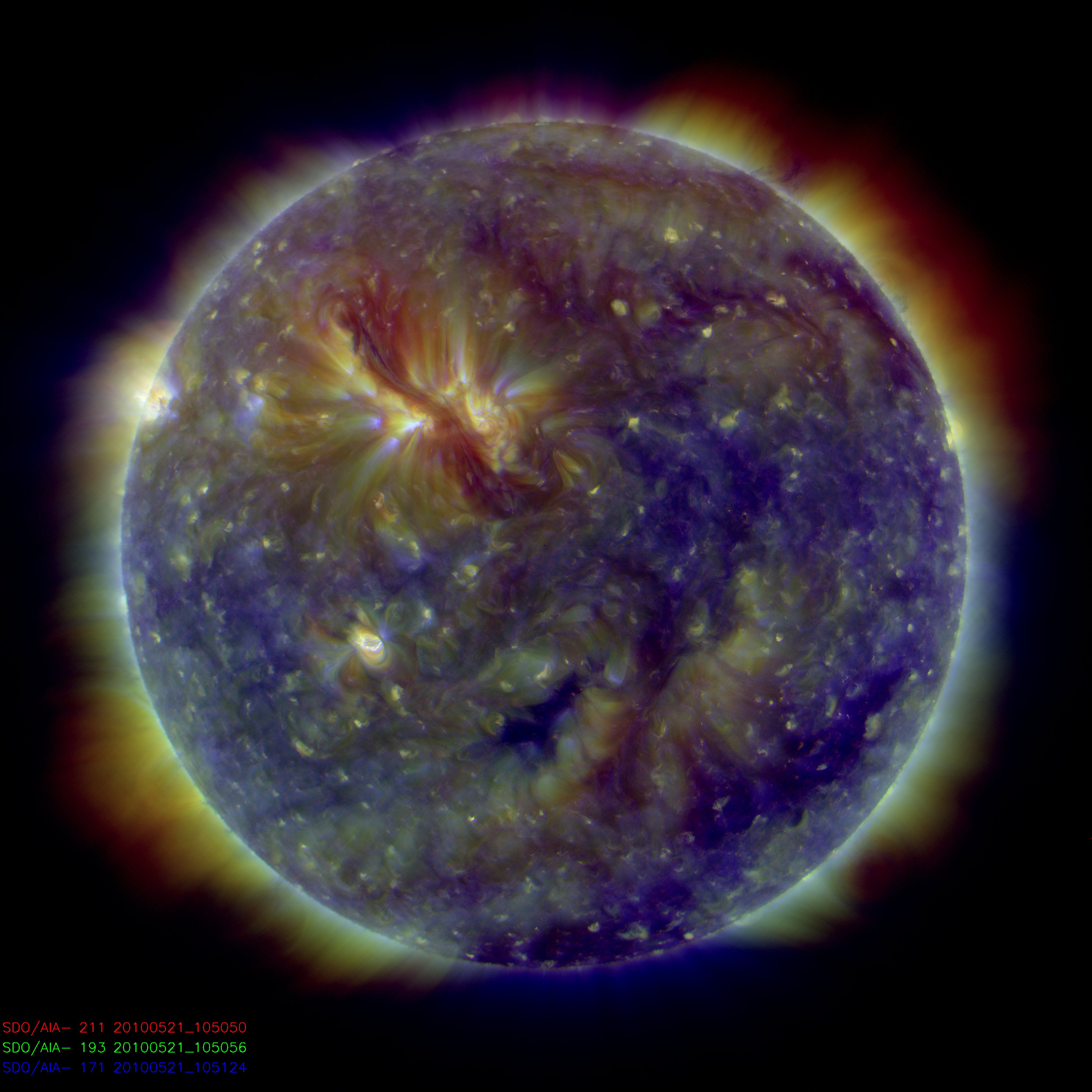
ALIEN BEAUTY: Multiwavelength images of the sun beamed to Earth by NASA's Solar Dynamics Observatory have a beauty that can only be described as ... alien. We've never seen the sun quite like this before. Consider the picture taken just hours ago by SDO's Atmospheric Imaging Assembly:
The image is a composite of three extreme ultraviolet wavelengths: 211 Å (false-color yellow) 193 Å (green) and 171 Å (blue), each tracing a different gas temperature ranging from 1 to 2 million degrees K. Highlights of today's sun include an enormous magnetic filament bisecting the northeastern quadrant, a coronal hole, and a new sunspot: labels. And that's just for starters. The high-resolution copy of this image shows many more weird and interesting things. Go ahead and take a look; it really is your star.
TOWARD THE END OF TIME
IT'S THE DANGER OF THE SUN
NEW A STAR NAMED HADES NEW
| 5-31-10 sunspots - 1073, 1074, 1075 Current conditions
speed: 538.3 km/sec density: 0.2 protons/cm3 explanation | more data Updated: Today at 0355 UT
6-hr max: A4 1800 UT May30 24-hr: A6 1735 UT May30 explanation | more data Updated: Today at: 2355 UT SPACE PLANE X-37B: The US Air Force's X-37B space plane is making a series of passes over North America this weekend. It shines about as brightly as the stars of the Big Dipper as it glides across the night sky. You can find the X-37B on your iPhone or check our Simple Satellite Tracker for flyby times.X-37B images: from Dan Bush of Albany, Missouri; from Farrell Germann of Jefferson City, Missouri; from Val Germann of Jefferson City, Missouri; from Gary of Fort Davis, Texas; from Jason Czech of Brimfield, Massachusetts; |
||||||||||||||
| 5-30-10 sunspots 1073, 1974,
1075 Current conditions
speed: 487.4 km/sec density: 2.9 protons/cm3 explanation | more data Updated: Today at 2345 UT
6-hr max: A4 1745 UT May30 24-hr: A6 1735 UT May30 explanation | more data Updated: Today at: 2340 UT |
||||||||||||||
5-29-10 three new sunspots are forming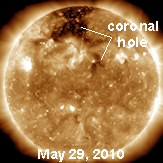 SUBSIDING STORM: A geomagnetic storm (Kp=5) that lasted for more than 9 hours on May 29th is subsiding now and the chances for auroras are subsiding with it. The next storm is due on May 31st or June 1st when a solar wind stream is expected to hit Earth's magnetic field. Current conditions
speed: 384.2 km/sec density: 1.0 protons/cm3 explanation | more data Updated: Today at 2346 UT
6-hr max: A5 1805 UT May29 24-hr: A5 1805 UT May29 explanation | more data Updated: Today at: 2340 UT
|
||||||||||||||
| 5-28-10 sunspot 1072 Current conditions
speed: 379.0 km/sec density: 6.3 protons/cm3 explanation | more data Updated: Today at 0205 UT
6-hr max: B1 2315 UT May27 24-hr: B1 2315 UT May27 explanation | more data Updated: Today at: 2355 UT FULL FLOWER MOON: There's a full Moon tonight and according to folklore it has a special name: the Flower Moon. In the northern hemisphere, spring flowers are abundant in May, and the full Moon illuminates them beautifully after sunset AURORA ALERT: High-latitude sky watchers should be alert for auroras tonight. A coronal mass ejection (CME) is heading for Earth and it could spark geomagnetic storms when it arrives on May 27th or 28th. The following preview comes directly from the geographic South Pole:
J. Dana Hrubes, who is wintering over at the pole as science leader of the Amundsen Scott Station, took the picture on May 20th. "It shows green and violet auroras swirling over the IceCube Neutrino Observatory," says Hrubes. When fully constructed, the NSF-sponsored observatory will use a cubic kilometer of south polar ice to catch and detect elusive neutrinos from distant black holes, supernovas and gamma-ray bursts. For now it makes nice foreground scenery for the Southern Lights.
|
||||||||||||||
| 5-27-10 sunspot 1072 Current conditions
speed: 313.9 km/sec density: 0.8 protons/cm3 explanation | more data Updated: Today at 2345 UT
6-hr max: B1 2315 UT May27 24-hr: B1 2315 UT May27 explanation | more data Updated: Today at: 2340 UT |
||||||||||||||
| 5-26-10 sunspot 1072 SOLAR ACTIVITY: A magnetic filament on the sun became unstable and slowly erupted on May 25th and 26th. Click on the image to launch a 1.2 MB movie recorded by the Solar and Heliospheric Observatory (SOHO): Unlike a similar filament that erupted on May 24th, hurling a CME now en route toward Earth, this filament was not facing our planet. We should feel no effects from the blast ... other than the impact of photogenic imagery. NASA's Solar Dynamics Observatory probably recorded the event as well; if so, movies ten times better than HDTV are in the offing. Stay tuned. Current conditions
speed: 347.3 km/sec density: 2.2 protons/cm3 explanation | more data Updated: Today at 2344 UT
6-hr max: A4 2200 UT May26 24-hr: A5 0435 UT May26 explanation | more data Updated: Today at: 2340 UT
|
||||||||||||||
| 5-25-10 sunspot 1072 SOLAR BLAST: A magnetic filament on the sun erupted yesterday, May 24th, and the blast hurled a coronal mass ejection (CME) in the general direction of Earth. NASA's Solar Dynamics Observatory recorded the action around the blast site in 10xHDTV resolution: Shortly after the eruption, the Solar and Heliospheric Observatory (SOHO) spotted a billion-ton CME racing away from the sun: movie. NOAA forecasters say there is a 35% chance of geomagnetic activity on May 27th when the cloud delivers a glancing blow to Earth's magnetic field. High-latitude sky watchers should be alert for auroras.
A new coronal hole is turning to face Earth. A solar wind stream flowing from this hole could reach our planet on or about May 31st. Credit: SDO/AIA Current conditions speed: 314.2 km/sec density: 1.4 protons/cm3 explanation | more data Updated: Today at 2346 UT
6-hr max: A4 2155 UT May25 24-hr: B4 1550 UT May25 explanation | more data Updated: Today at: 2340 UT SECRET SPACE PLANE: NASA's space shuttle program may be winding down, but the US Air Force's is just getting started. On April 22nd, the USAF launched an unmanned mini-shuttle from Cape Canaveral on a secret mission widely thought to involve reconnaissance. The X-37B can now be seen gliding through the night sky shining about as brightly as the stars of the Big Dipper. On Sunday night, Gary O. photographed it streaking over the treetops of his home in Fort Davis, Texas:
"This was my first chance to photograph the X-37B," says Gary. "It was easy to see. I estimate its magnitude at about +2.8." The whereabouts of the X-37B were unknown until May 20th when amateur satellite watchers Greg Roberts of Cape Town, South Africa, and Kevin Fetter of Brockville, Canada, independently spotted it. Another satellite sleuth, Ted Molczan of Toronto, Canada, combined their observations to determine the space plane's orbit. With this information in hand, Fetter was able to find the X-37B again the next night; here it is on May 21st passing the 3rd-magnitude star Sadalsuud in Aquarius. |
||||||||||||||
| 5-24-10 Sunspot 1072 Current conditions
speed: 310.4 km/sec density: 1.0 protons/cm3 explanation | more data Updated: Today at 1304 UT
6-hr max: A6 0805 UT May24 24-hr: A9 0030 UT May24 explanation | more data Updated: Today at: 1305 UT
|
||||||||||||||
| 5-23-10 Sunspot 1072
SIZZLING SUNSPOT: Yesterday, NASA's Solar
Dynamics Observatory (SDO) peered into the dark heart of sunspot 1072
and found it sizzling with activity. Click on the link to set the scene
in motion: http://www.spaceweather.com/swpod2010/24may10/ipad/ipad/sunspot1072_aia171.m4v?PHPSESSID=fhhflk58j2h79fc6irfint96r4 The curvaceous arcs in this extreme ultraviolet (171 Å) image are magnetic flux tubes filled with million-degree plasma. Occasionally, a magnetic instability causes an explosion, a minor solar flare, which appears in the movie as a brief flash of light. None of these B-class flares was strong enough to effect Earth; they were merely photogenic. According to NOAA forecasters, sunspot 1072 harbors energy for flares 100 times stronger than this, and there is a 10% chance of such an M-class eruption during the next 24 hours. Shortwave radio blackouts, sudden ionospheric disturbances, and some fantastic movies from SDO could be in the offing Current conditions
speed: 355.1 km/sec density: 0.3 protons/cm3 explanation | more data Updated: Today at 2234 UT
6-hr max: B1 1840 UT May23 24-hr: B1 1840 UT May23 explanation | more data Updated: Today at: 2235 UT |
||||||||||||||
| 5-22-10 - sunspot 1072 Current conditions
speed: 379.2 km/sec density: 0.6 protons/cm3 explanation | more data Updated: Today at 2103 UT
6-hr max: A8 1635 UT May22 24-hr: A8 1635 UT May22 explanation | more data Updated: Today at: 2100 UT WATCH VIDEO http://www.youtube.com/watch?v=Hfy2JMcyMyA The Norway spiral comes to mind when TheWeatherSpace.com received photographs and even an amazing video of the event. An object swooped down from the sky and then returned in a brilliant display on Friday night across the Western Canada areas.
BLUE BEAM SPIRAL IN THE SKY
The Norway Spiral has stunned the world with a remarkable
appearance last week. The spiral has been called the coming
of the new age, aliens visiting from ...
www.greatdreams.com/ufos/norway/Norway-Blue-Beam.htm
Big Mystery: Jupiter Loses a StripeLost: A giant belt of brown clouds big enough to swallow Earth twenty times over. If found, please return to Jupiter. May 20, 2010: In a development that has transformed the appearance of the solar system's largest planet, one of Jupiter's two main cloud belts has completely disappeared."This is a big event," says planetary scientist Glenn Orton of NASA's Jet Propulsion Lab. "We're monitoring the situation closely and do not yet fully understand what's going on."
These side by side images of Jupiter taken by Australian
astrophotographer Anthony Wesley show the SEB in August 2009,
but not in May 2010.Individual images:
Aug. 4, 2009;
May 8, 2010.
Known as the South Equatorial Belt (SEB), the brown cloudy band is
twice as wide as Earth and more than twenty times as long. The loss of
such an enormous "stripe" can be seen with ease halfway across the solar
system. "In any size telescope, or even in large binoculars, Jupiter's
signature appearance has always included two broad equatorial belts,"
says amateur astronomer Anthony Wesley of Australia. "I remember as a
child seeing them through my small backyard refractor and it was
unmistakable. Anyone who turns their telescope on Jupiter at the moment,
however, will see a planet with only one belt--a very strange sight."
Wesley is a veteran observer of Jupiter, famous for his discovery of
a comet hitting the planet in 2009. Like many other astronomers, he
noticed the belt fading late last year, "but I certainly didn't expect
to see it completely disappear," he says. "Jupiter continues to
surprise." Orton thinks the belt is not actually gone, but may be just hiding
underneath some higher clouds. 
Without the SEB present, Jupiter's Great Red Spot is surrounded
by almost uninterrupted white. Anthony Wesley took this picture
on May 18, 2010. [larger
image]
"It's possible," he hypothesizes, "that some 'ammonia cirrus' has
formed on top of the SEB, hiding the SEB from view." On Earth, white
wispy cirrus clouds are made of ice crystals. On Jupiter, the same sort
of clouds can form, but the crystals are made of ammonia (NH3) instead
of water (H20). What would trigger such a broad outbreak of "ammonia cirrus"? Orton
suspects that changes in global wind patterns have brought ammonia-rich
material into the clear, cold zone above the SEB, setting the stage for
formation of the high-altitude, icy clouds. "I'd love to send a probe in there to find out what's really going
on." Indeed, Jupiter's atmosphere is a mysterious place which would
benefit from exploration. No one knows, for instance, why the Great Red
Spot is red—or what has sustained the raging storm for so many years.
Neither does theory explain why the twin equatorial belts are brown, nor
why one should vanish while the other remains. "We have a long list of
questions," says Orton. This isn't the first time the SEB has faded out. "The SEB fades at irregular intervals, most recently in 1973-75,
1989-90, 1993, 2007, 2010," says John Rogers, director of the British
Astronomical Association's Jupiter Section. "The 2007 fading was
terminated rather early, but in the other years the SEB was almost
absent, as at present." The return of the SEB can be dramatic. 
Jupiter beckons to amateur astronomers from the pre-dawn sky.
Lyle Anderson of Duluth, Minnesota, took this picture on May 19,
2010. [larger
image] [sky
map]
"We can look forward to a spectacular outburst of storms and vortices
when the 'SEB Revival' begins," says Rogers. "It always begins at a
single point, and a disturbance spreads out rapidly around the planet
from there, often becoming spectacular even for amateurs eyeballing the
planet through medium-sized telescopes. However we can't predict when or
where it will start. On historical precedent it could be any time in the
next 2 years. We hope it will be in the next few months so that everyone
can get a good view. "I'll be watching every chance I get," says Wesley. "The revival will
likely be sudden and dramatic, with planet-circling groups of storms
appearing over the space of just a week or so." Indeed, says Orton, "anyone could be the first to spot the return of
the SEB." Jupiter shines in the eastern sky before dawn: sky map. Point your optics at the "morning star" and … is that really Jupiter? Happy hunting!
|
||||||||||||||
| 5-21-10 Sunspot - 1072 NEW SUNSPOT: Magnetic fields are bursting through the surface of the sun and coalescing to form a new sunspot in the sun's southeastern quadrant. Rogerio Marcon sends this picture of the active region from his backyard observatory in Campinas, Brasil:
"Many magnetic structures are visible in my H-alpha telescope," says Marcon. "It is a great view!" The sunspot's dark core is growing rapidly, more than doubling in size since the day (May 21st) began. It does not yet pose a threat for significant solar flares, but if its growth proceeds apace, the sunspot could be a source of eruptions during the weekend. The emergence of this not-net-numbered active region breaks a string of 12 days without sunspots. more images: from Cai-Uso Wohler of Bispingen, Germany; from Pavol Rapavy of Observatory Rimavska Sobota, Slovakia
Current conditions
speed: 436.6 km/sec density: 1.2 protons/cm3 explanation | more data Updated: Today at 2345 UT
6-hr max: A6 2205 UT May21 24-hr: A6 2205 UT May21 explanation | more data Updated: Today at: 2340 UT |
||||||||||||||
| 5-20-10 No sunspots today MAGNETIC MEGA-FILAMENT: For the fourth day in a row, a dark magnetic filament is bisecting the sun's northeastern quadrant. Measuring more than 100,000 km from end to end, it is literally the biggest thing on the face of our star. NASA's Solar Dynamics Observatory has a good view of the structure. The 2-hour time lapse movie recorded around 0600 UT on May 20th shows relatively cool plasma flowing through the filament's magnetic walls. Long, active filaments like this have been known to grow unstable and erupt, producing a type of spotless flare called a "Hyder flare." If that happens now, Earth would likely feel some effects from the blast because the filament is turning to face our planet. Current conditions
speed: 466.8 km/sec density: 1.2 protons/cm3 explanation | more data Updated: Today at 2345 UT
6-hr max: A2 2210 UT May20 24-hr: A5 0550 UT May20 explanation | more data Updated: Today at: 2340 UT |
||||||||||||||
| 5-19-10 no sunspots today
Current conditions
speed: 476.4 km/sec density: 7.3 protons/cm3 explanation | more data Updated: Today at 1546 UT
6-hr max: A2 1530 UT May19 24-hr: A2 0600 UT May19 explanation | more data Updated: Today at: 1540 UT |
||||||||||||||
| 5-18-10 no sunsot today SOLAR FILAMENT: A long, dark magnetic filament is snaking over the sun's northeastern limb today, providing some relief to an otherwise blank solar disk. Pete Lawrence sends this picture from his backyard observatory in Selsey, UK:
Unlike many filaments, which soar up high in lovely arch- and twister-shapes, this one seems to be hugging the stellar surface. That doesn't mean the region is uninteresting, though. NASA's Solar Dynamics Observatory has been recording plenty of activity in the filament's vicinity: movie. Readers with solar telescopes are encouraged to monitor developments. Current conditions
speed: 361.1 km/sec density: 11.2 protons/cm3 explanation | more data Updated: Today at 2345 UT
6-hr max: A2 2230 UT May18 24-hr: A2 0010 UT May18 explanation | more data Updated: Today at: 2340 UT |
||||||||||||||
| 5-17-10 no sunspots today Current conditions
speed: 361.3 km/sec density: 0.3 protons/cm3 explanation | more data Updated: Today at 2346 UT
6-hr max: A2 2240 UT May17 24-hr: A2 2240 UT May17 explanation | more data Updated: Today at: 2340 UT LUNAR OCCULTATION: Yesterday, sky watchers in parts of Africa, the Middle East, India and southeast Asia witnessed a spectacular lunar occultation of Venus. "People were awestruck and 'frozen to their feet' at the park where we watched the event," reports Armando Lee of San Miguel by the Bay, the Philippines. He took this picture using a Canon 350D at the prime focus of a 5-inch Orion telescope:
Venus disappeared for more than 40 minutes behind the lunar disk, but the long absence wasn't the attraction. It was the transitions into and out of eclipse that really impressed onlookers. "Ingress looked like a diamond ring - Tiffany style - while egress looked like an eruption on the crescent Moon!" says Lee. |
||||||||||||||
| 5-16-10 no sunspots today Current conditions
speed: 352.3 km/sec density: 0.3 protons/cm3 explanation | more data Updated: Today at 2346 UT
6-hr max: A2 1830 UT May16 24-hr: A2 1830 UT May16 explanation | more data Updated: Today at: 2340 UT |
||||||||||||||
| 5-15-10 no sunspots today Current conditions
speed: 368.4 km/sec density: 0.1 protons/cm3 explanation | more data Updated: Today at 2345 UT
6-hr max: A2 2125 UT May15 24-hr: A2 0505 UT May15 explanation | more data Updated: Today at: 2340 UT |
||||||||||||||
| 5-14-10- no sunspots today Current conditions
speed: 395.2 km/sec density: 0.2 protons/cm3 explanation | more data Updated: Today at 2343 UT
6-hr max: A2 2015 UT May14 24-hr: A2 2015 UT May14 explanation | more data Updated: Today at: 2340 UT
|
||||||||||||||
| 5-13-10 n0 sunspots today Current conditions
speed: 383.1 km/sec density: 0.2 protons/cm3 explanation | more data Updated: Today at 2344 UT
6-hr max: A2 2155 UT May13 24-hr: B2 0355 UT May13 explanation | more data Updated: Today at: 2340 UT |
||||||||||||||
| 5-12=10 no sunsots today Current conditions
speed: 486.6 km/sec density: 0.1 protons/cm3 explanation | more data Updated: Today at 2345 UT
6-hr max: A4 2030 UT May12 24-hr: B1 1405 UT May12 explanation | more data Updated: Today at: 2340 UT |
||||||||||||||
| 5-11-10 no sunspots today Current conditions
speed: 383.0 km/sec density: 5.7 protons/cm3 explanation | more data Updated: Today at 2345 UT
6-hr max: B1 2015 UT May11 24-hr: B1 2015 UT May11 explanation | more data Updated: Today at: 2340 UT IONOSPHERIC DISTURBANCE: On May 5th, a pair of solar flares bathed Earth's upper atmosphere in X-rays and caused a double-wave of ionization to sweep over the Americas. This improved the propagation of low-frequency radio signals, which use the ionosphere as a reflector to skip over the horizon. Rogerio Marcon of Campinas SP Brasil was monitoring a 24 kHz aviation beacon when the flares occurred, and he recorded a double-surge in the beacon's signal strength:
Each of the spikes is called a "SID," short for sudden ionospheric disturbance. One was produced by a C9-class flare at 11:52 UT; the other by a slightly stronger M1-class flare at 17:19 UT. The two SIDs ride atop a slower undulation in radio signals caused by the daily rising and setting of the sun. In terms of radio propagation, the two flares were as significant as the sunrise itself!With solar activity on the rise, sudden ionospheric disturbances will become more common. Interested? Stanford University tells you how to build your own SID monitor.
|
||||||||||||||
| 5-10-10 no sunspots today Current conditions
speed: 364.4 km/sec density: 2.2 protons/cm3 explanation | more data Updated: Today at 0004 UT
6-hr max: B2 2110 UT May09 24-hr: B2 2110 UT May09 explanation | more data Updated: Today at: 2350 UT
On the Richter scale of solar flares, the eruption you just witnessed registered C2.4. In years past, solar physicists regarded C-flares as minor events, but SDO is revealing them to be quite spectacular. Plasma plumes accelerating out of the blast site are filled with magnetized gas hotter than 80,000 K and are big enough to swallow Earth itself. Earth was not, however, in the line of fire, so we will feel no geomagnetic effects from these events. Here are three more highlights from May 8th: C1.8-flare, C9-flare, B7-flare. These were selected from the Lockheed Martin Solar and Astrophysics Laboratory's excellent latest events web site. Instigating sunspot 1069 is rotating over the sun's western horizon, out of sight of Earth and SDO, so the show is over for now. It probably won't be long, however, before SDO turns another "minor" eruption into a jaw-dropping spectacle. BONUS: SDO also observed a pair of impressive eruptions on May 5th: This one sent a "solar tsunami" rippling through the sun's atmosphere and this one propelled a massive magnetic filament off the sun's western limb |
||||||||||||||
| 5-9-10 - sunspot 1069 Current conditions
speed: 362.2 km/sec density: 1.0 protons/cm3 explanation | more data Updated: Today at 2345 UT
6-hr max: B2 2110 UT May09 24-hr: B2 2110 UT May09 explanation | more data Updated: Today at: 2340 UT |
||||||||||||||
5-8-10 - sunspot 1069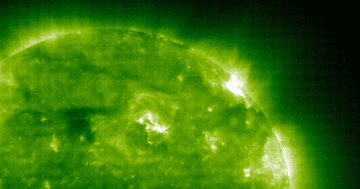 Photo details: SOHO Extreme UV Telescope; May 8, 0000 - 1600 UT CRACKLING SUNSPOT: The magnetic fields of sunspot 1069 are in a state of considerable agitation today. Click on the image, below, to launch a 16-hour time-lapse movie from the Solar and Heliospheric Observatory (SOHO):
Current conditions
speed: 436.2 km/sec density: 0.3 protons/cm3 explanation | more data Updated: Today at 2345 UT
6-hr max: C2 2010 UT May08 24-hr: C6 0500 UT May08 explanation | more data Updated: Today at: 2340 UT
|
||||||||||||||
| 5-7-10 - sunspot 1070 is gone, but 1069 is back Current conditions
speed: 497.8 km/sec density: 1.7 protons/cm3 explanation | more data Updated: Today at 1336 UT
6-hr max: C2 0740 UT May07 24-hr: C2 0740 UT May07 explanation | more data Updated: Today at: 1330 UT |
||||||||||||||
| 5-6-10 - Sunspot 1070 Current conditions
speed: 527.4 km/sec density: 0.4 protons/cm3 explanation | more data Updated: Today at 2204 UT
6-hr max: A8 1830 UT May06 24-hr: B2 0620 UT May06 explanation | more data Updated: Today at: 2205 UT
|
||||||||||||||
| 5-5-10 - sunspots 1067, 1068, 1069 ACTIVE SUNSPOT: New sunspot 1069 is growing rapidly (updated: movie) and crackling with C-class solar flares. Located near the sun's northwestern limb, the sunspot is by far the most active region on the sun. Readers with solar telescopes are encouraged to monitor developments. Current conditions
speed: 551.6 km/sec density: 0.2 protons/cm3 explanation | more data Updated: Today at 2345 UT
6-hr max: B5 1840 UT May05 24-hr: C7 1150 UT May05 explanation | more data Updated: Today at: 2340 UT
With May 5th winding down, magnetic fields on
the sun wound up and erupted, producing a bright coronal mass ejection
(CME). Click on the image to set the cloud in motion:
The eruption came from a spotless region near the sun's southwestern limb. Extreme ultraviolet images from SOHO pinpoint the blast site: movie. The billion-ton cloud is not heading directly for Earth, although it could deliver a glancing blow to our planet's magnetic field on or about May 8th. High-latitude sky watchers should be alert for auroras this weekend.
May 2010 Aurora Gallery
|
||||||||||||||
| 5-4-10 - sunspots 1066, 1067, 1068 Current conditions
speed: 597.6 km/sec density: 0.4 protons/cm3 explanation | more data Updated: Today at 2345 UT
6-hr max: B3 1745 UT May04 24-hr: C2 1625 UT May04 explanation | more data Updated: Today at: 2340 UT
METEORS FROM HALLEY'S COMET: The eta Aquarid meteor shower, caused by dust from Halley's Comet, peaks this year on May 7th. The shower is strongest over the southern hemisphere, where observers could see more than 30 meteors per hour despite the bright light of a waning half Moon. No matter where you live, the best time to look is during the hours before local sunrise on Friday. [full story] |
||||||||||||||
| 5-3-10 - sunspot
1066 and 1067 are small but growing Explosion on the sun - CORONAL MASS EJECTION: Something exploded on the sun this morning, hurling a coronal mass ejection (CME) into space: movie. The source of the blast is not yet known. The cloud, however, does not appear to be heading toward Earth. 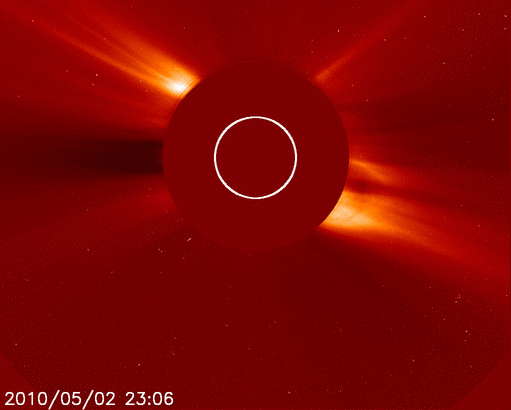 Current conditions
speed: 675.6 km/sec density: 0.5 protons/cm3 explanation | more data Updated: Today at 0945 UT
6-hr max: A9 0605 UT May03 24-hr: A9 0605 UT May03 explanation | more data Updated: Today at: 0945 UT 5-2-10 - Sunspot has no name NO-NAME ACTIVE REGION: An unstable nest of magnetic fields emerged over the sun's northeastern horizon yesterday, and it is crackling with C-class solar flares. Astrophotographer Pete Lawrence sends this picture from his backyard observatory in Selsey, UK:
Although the maelstrom does have a small dark core, technically making it a sunspot, it has not yet been sunspot-numbered by NOAA. Readers with solar telescopes are encouraged to keep an eye on the no-name active region--it's where the action is.
|
||||||||||||||
Current conditions
speed: 621.8 km/sec density: 0.4 protons/cm3 explanation | more data Updated: Today at 2345 UT
6-hr max: B1 2150 UT May02 24-hr: B3 1010 UT May02 explanation | more data Updated: Today at: 2340 UT
|
||||||||||||||
| 5-1-10 no sunspots BIG TWISTER: On May 1st, a magnetic filament on the sun wound itself into a twist and erupted. NASA's STEREO Ahead spacecraft was in the perfect position to observe the blast. Click on the image to set the scene in motion: 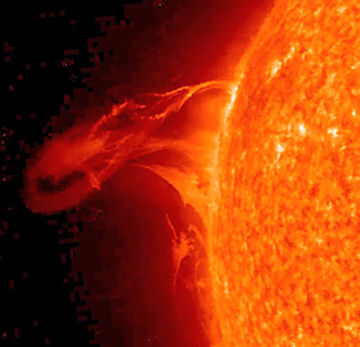 The time-lapse spans three days, April 30th to May 2nd, and shows not only the big twister, but also many smaller filaments that twist and swirl without erupting. Such activity occurs every day and is part of the dynamism of the ever-changing sun. Coronal Hole 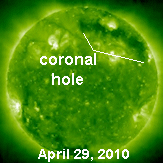 A solar wind stream flowing from the indicated coronal hole could reach Earth on or about May 3rd. Credit: STEREO-B Extreme UV Telescope SPACE DATABASE ON THIS SITE DREAMS OF THE GREAT EARTHCHANGES - MAIN INDEX |
||||||||||||||